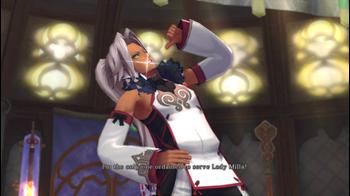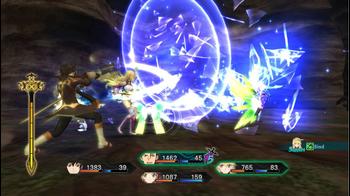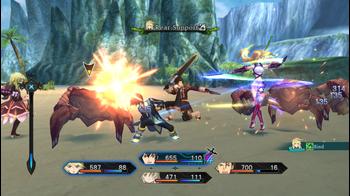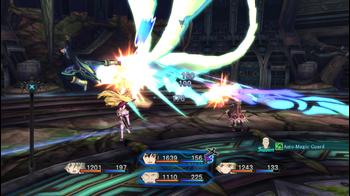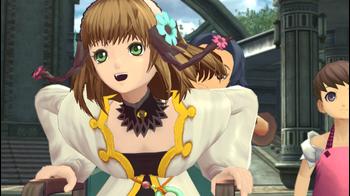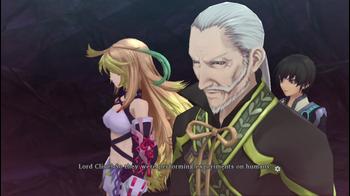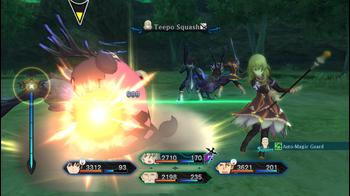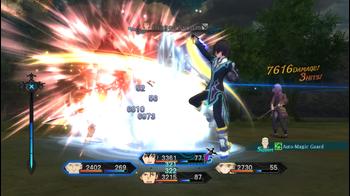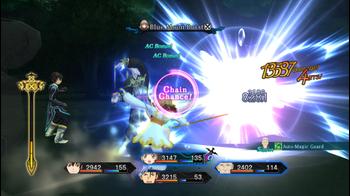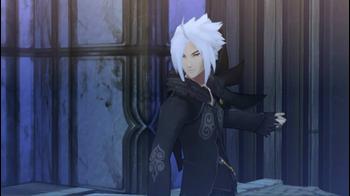Tales of Xillia Review
Conviction. Will. Ideals. Identity. Mission. These are the various ideas that Tales of Xillia dabbles with and while they are interesting in nature, they’re not greatly executed. The game is a breed of traditional traits expanding its horizon in hopes of modernizing the franchise. While the original release was two years ago in Japan, is the game a little too late that doesn’t warrant your attention, or is it one that stands high and mighty amongst its JRPG peers?
Tales games have been known for its deep roots in character interaction and character growth and with Xillia it’s no different. While Vesperia tackled some darker themes such as murdering in the name of one’s justice, it didn’t particularly expand upon it nor did it do anything particularly special with it. Xillia is a much darker game in comparison due to the various ideas that characters personify. These ideas clash and when it escalates on a level that could decide the fate of a world you have a fairly standard premise for a game.
Xillia takes it one step further with two main ideas that influence and permeate the game’s narrative from beginning to end. Will and conviction. When these ideas stand alone they don’t mean anything but put them together and you have actions and results. Every character in Xillia depicts a level of will and conviction and it’s important to note them. For instance Milla’s convictions lead her to save a world so that man and spirit will live harmoniously. Conviction alone is not enough. The will to carry out those beliefs is just as important and Milla exemplifies and indomitable will, one that drastically changes the fate of those around her. The execution is solid and the impact it has on the people that travel around her is felt and even moreso as everyone struggles to find his or her place in the world.
Beliefs are extremely important and finding how one must live is a constant question that each character asks him/herself. Jude struggles to find what his mission is and Alvin struggles with where to place his trust. These weaknesses that the cast of Xillia exhibits becomes a focal point in delivering a strong narrative and top that off with a diverse set of characters that truly differentiate themselves and you have a recipe for awesome. While in previous games the characters always dealt with problems and grew as a result, they rarely looked at the root of the character’s faults and weaknesses. In Xillia it brings them to the surface by showing how one’s problems can be quickly reversed into strength but most importantly, the other way around. And so, Xillia adds a new layer of narrative telling which doesn’t rely heavily on character interaction but the characters’ identities.
This doesn’t mean character interactions aren’t great. Rather, Xillia’s cast is a very diverse one. These characters are bound not by the need to treat each other nicely or by formalities or by their friendship but by the mission to save the world. Problems and conflicts are frequent as a result so characters can be on edge or may reply snidely to certain personality faults that exist within others. Because of this the party interaction in Xillia feels more genuine and by the game’s end there is a level of comraderie not because they share the same idea or because they are friends or because they have the same beliefs. Far from it, Xillia’s characters by the game’s end accept and live with the faults of those around them. There is a variety of positive and negative character interactions that catch the player’s eyes whether it be through the cutscenes or the funny skits that are littered throughout the game. Jokes will be had. Laughter will be common. However, so will strife, despair, and hardships. Diverse doesn’t always mean a good thing but in Xillia the plethora of interaction types make it a worthwhile experience.
Sadly the game falls on its knees due to the plot. Throughout the game’s 40-hour journey, the characters travel the world of Rieze Maxia attempting to save humanity and spirits, overcome political struggles, and prepare themselves for dark mysteries that stalk them. None of them are truly interesting and this is due to each situation lacking a sense of urgency. In short, there is no real sense of danger a need for hurry when progressing through the game. Destroying a device that can ruin mankind is marred by how nonchalant and relatively calm the characters are and as a result, the importance of these missions appear mundane.
In addition, the game features two main protagonists. From the beginning you have the option to play as Jude or Milla and while you can control either of them in the field of battle, there will be points in the story where they will be separated. The storytelling is definitely different as Xillia attempts to tell its tale from two different perspectives. This creates an odd situation where pieces of the puzzle are withheld from the player until both sides are completed. Many of the portions are repeated on the other side of the campaign and it can be a drag to go through it to solve the remaining mysteries. At best the execution is a poor one.
There is a variety of tunes that stand out in Xillia and it is a thrill to hear the various ambient and bombastic music that can stream out from the television or a sound system. Sadly, many tunes are overplayed and sometimes misused. The songs that play often tend to be the rather underwhelming ones. The good ones are sitting in the closet and only used for truly important scenes and while this can be seen as a positive it’s definitely not a case of “little is more.”
What the plot does well is its extremely well-paced and lack-of-filler characteristics. While previous Tales games were padded out with rather unimportant events, Xillia keeps a tight noose around what the cast is supposed to be doing at a given time. Everything relates in some way to the main mission at hand.
Xillia is prejudiced in the fact that it doesn’t want to handhold the player. The game is seamless in trying to depict a thriving world with various problems. There isn’t a manual explaining what the various terms are and it doesn’t try to explain every single detail all the time. What you do end up getting as a result is a situation where you end up asking questions about what something is and as the game goes on it answers them through context. Xillia forces the players to ask questions rather than spoon feeding them information. Consequently, while all of the characters are familiar with the various workings of Rieze Maxia, you as the player are not. This dichotomy is effectively portrayed since characters aren’t taking five minutes to explain an idea that the rest of the cast should already know. In a way, the player is a fish out of water and new to the world. It’s both a well-executed and is a neat way of telling the story.
All of the excellent narrative elements are substantiated by the game’s superb English dub. Emotions run high in various situations and the wide range of emotions that the voice cast bring to the table offer the potential to deeply immerse players into the narrative experience. Each voice is fitting to the characters. The stoic and unyielding Gaius has a deep resounding voice that sends chills with every word he utters and the shy and young Elize portrays a sense of naivety and innocence. The voices incorporated into the game is definitely a step up compared to the previous games.
Unfortunately, not everyone sounds great and is presented well. While Milla’s voice is perfect for her character, the delivery can be dry and rather robotic at times. Often times it’s hard to know what emotion she is showing and it can lead to something monotonous. On the other hand, there are characters such as Agria who have lines said in a way so overly dramatic and insane it’s hard to note it as anything but cheesy and ridiculous.
Tales of Xillia is heavy handed when it comes to delivering a deep narrative experience but the brunt of the joy is going to be had with the dynamic combat system. Staying true to its franchise core, Xillia uses a combat system where characters fight on a line much like a fighting game with a mix of regular attacks and Artes, the game’s special abilities. You mix and match these two types of attacks with two types of resources that dictate how you approach each enemy: AC and TP.
The Assault Counter (AC) dictates how many times you can attack whether it be normal attacks or Artes. It’s easy to refill them as you just stand still momentarily. Technical Points (TP) are the game’s equivalent of mana that dictates your Arte pool. Each Arte consumes a certain amount of TP and to replenish them you must use normal attacks. These two resources are extremely restrictive at first and it stays that way for the most part. While there is a larger pool of TP to use by the game’s end, the AC prevents you from pulling off some radical amount of awesome Artes. The problem is there aren’t many options for refilling your AC in the middle of an assault which pretty much limits how you can approach an enemy.
Linking is the huge battle addition in Xillia and it’s no simple gimmick. While there are a total for four combatants out on the field, each of them have the potential to link with one partner. These partners are able to attack an enemy in unison, use special abilities to assist allies, and offer cover for encroaching foes. It’s a nice idea with various benefits and advantages.
The most notable offering from Linking is the use of Link Artes. When a certain Arte is used, you have the opportunity to initiate a Link Arte with your linked partner. These devastating attacks deal massive damage but most important work towards building the Overlimit gauge which can be used to link together multiple Link Artes for a massive combo. Using these combos isn’t as simple as just mashing a certain Arte. Combining the right order of Link Artes and linking with the proper characters in your party will yield more damage than simply spamming them. It’s a unique dynamic that changes how one approaches battles and what strategy to deploy. Unfortunately there aren't many Link Artes across all characters and this limitation is a huge disappointment.
Linking will also offer advantages through the various skills that you can equip. Skills help to expand a character’s unique traits such as dishing out more damage by charging spirit Artes or expanding the usage of certain Artes. Most importantly, you can use certain skills that will benefit your linked partner. These abilities can stack which further incentivizes linking and working in combination with a comrade in battle. Linking is definitely not a simple gimmick as it is simply another asset that can be used for dispatching your enemies. Will you gear your characters towards to access Link Artes easier or perhaps just brute strength. There’s a variety of options to consider and the system revolving around Linking is a boon.
While the combat system is fun to mess around with on normal enemies it’s not fun at all when playing against bosses. Frequent combo breaking is an instant killjoy. There’s a lack of control and the way the game decides to change up how bosses are engaged is an unwarranted change.
While characters still level in the game, the implementation is odd. The Lilium Orb is a mix of the Crystarium and Sphere Grid systems from Final Fantasy. There is a web of orbs and by activating each node, the character gains the stats associated with the node. When multiple nodes are connected to encompass an area, a skill housed inside becomes available. Appearances can be deceiving. While the player may appear to be free with how they grow their character using the Lilium Orb system, they greatly benefit from focusing on certain attributes. Jude is bolstered primarily through the physical attack attribute while Elize from magic. These illusions and limitations are frustrating to work around because the freedom of customizing a character is practically non-existent.
To further enhance the party’s strength the game houses a dynamic shopping experience. Rather than entering a new town and looking for new gear and goods, the player has the option to use money or items to expand the shop’s inventory. New weapons, armors, healing items, etc can be bought by upgrading the shops. Old items will be discounted and newer ones will be sold at exorbitant prices. This means that if you have the extra cash or an abundance of useless items you have the opportunity to be rewarded with new gear available for purchase. If you want to focus on advanced gear on a select few rather than rounding out the entire party this option is also available. The choices offered with this design are an interesting one and adds an interesting aspects in the art of commerce.
There is a large emphasis on traveling from one location to another. While the various cities and towns look beautiful and fill the atmosphere with a certain mystique, the areas located in between are an absolutely disaster. Nearly all these in-between areas are used for traveling from one major location to another and it’s disappointing that the journey is ruined by big empty sandboxes often filled with useless “treasures.” Not only this but nearly all of these areas look the same but with a different color palette adding oil to the fire. It’s a joy to explore the various unique areas that the game has to offer such as the exquisite nighttime view of Fennmont or the rocky city of Xian Du and it’s disappointing to know that not all the areas could’ve used the same amount of work or retained consistent quality.
Housed in each city are numerous people that need help. The ones needed your particular services are marked with exclamations above their heads. If you talk to them you will accept the side quest and it’ll be recorded in the Events log. There are a great number of side quests to fulfill and all of them are attained in this fashion. For the most part the side quests are a neat way of gaining new items, money, or just earning titles which are used for New Game +. The side quests feel like padding and there aren’t a variety of quests to pique your interest. However, their offerings shouldn’t go unnoticed.
The New Game + is a savior for those who want to go through both character narratives without taking a long while. Using the Grade accrued from titles, you can add new features such as faster experience gain or carrying over levels. It definitely speeds up on the pace if you don’t want to see the copy and paste scenes.
The game is not without technical faults, however. The game experiences frequent slowdowns when multiple enemies are on the field and various particles are flying around everywhere, even moreso than the Japanese version. While the visuals do look great for the most part, the environmental textures look flat and blurred resulting in some problems when the camera zooms in during cutscenes. The characters themselves in battle move with stunning grace and a high level of fluidity but feel very lifeless and mechanical during cutscenes as well. These issues don’t deter the game experience greatly but it still remains as a problem.
Perhaps the most interesting fault, and while it’s a fault within the context of the franchise, is the noticeable lack of Tales gameplay elements. The way you earn Grade is completely changed, cooking is removed, synthesis and the traditional methods of upgrading have been revamped or taken out altogether, and the game lacks a cameo fight as well. Many of the staples known in the franchise is seemingly missing and the game greatly suffers for it, and in that respect Xillia is disappointing.
Tales of Xillia is a well-crafted game that executes many of its ideas extremely well. The narrative is engaging and draws the player in for an experience that is both familiar and old to newcomers and veterans alike. However, there is an alienation that occurs due to how long it’s been since its original release. While it’s not a case of a simple “a little too late” it’s not timely either. Still, what Xillia offers should not be missed amongst JRPG fans and gamers yearning for a fun and addictive combat system.
Disclaimer: A copy of the game was provided by the publisher for review purposes.
